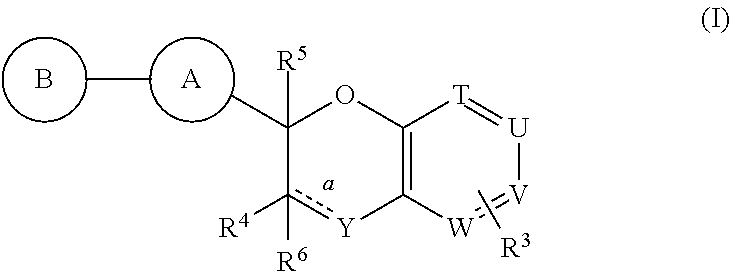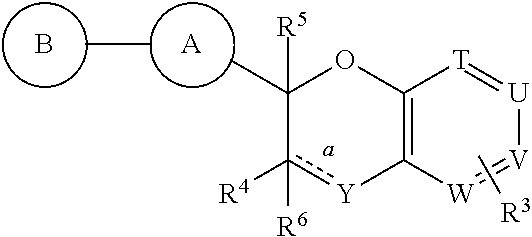Antidiabetic bicyclic compounds
a technology antidiabetic peptides, applied in the field of antidiabetic bicyclic compounds, can solve the problems of increased and premature morbidity and mortality, inadequate insulin-mediated repression of lipolysis in adipose tissue, and insufficient insulin-mediated activation of uptake, oxidation and storage of glucose in muscle,
- Summary
- Abstract
- Description
- Claims
- Application Information
AI Technical Summary
Benefits of technology
Problems solved by technology
Method used
Image
Examples
example 1
3-(2-(2′,6′-dimethyl-[1,1′-biphenyl]-3-yl)chroman-6-yl)propanoic acid
[0925]
Step A: (E)-methyl 3-(2-(2′,6′-dimethyl-[1,1′-biphenyl]-3-yl)chroman-6-yl)acrylate
[0926]
[0927]To a nitrogen-purged vial containing 6-bromo-2-(2′,6′-dimethyl-[1,1′-biphenyl]-3-yl)chroman (165 mg, 0.420 mmol), Pd2(dba)3 (7.68 mg, 8.39 μmol), and tri-t-butylphosphine (3.39 mg, 0.017 mmol) sealed with a teflon screw cap was added dioxane. N-cyclohexyl-N-methylcyclo-hexanamine (90 mg, 0.461 mmol) and methyl acrylate (0.076 ml, 0.839 mmol) were then added via syringe. The mixture was stirred at room temperature for 12 h. The reaction mixture was then poured into water (10 mL) and then extracted with diethyl ether (2×10 mL). The combined organic layers were dried (MgSO4) and concentrated. The resulting residue was purified by HPLC (ISCO 24 gram cartridge, 0 to 50% EA / Hex) to give the title compound. 1H NMR (500 MHz, CDCl3) δ7.65 (d, 1H), 7.51-7.10 (m, 9H), 6.94 (d, 1H), 6.34 (d, 1H), 5.19 (d, 1H), 3.81 (s, 3H), 3.02...
example 7
3-(2-(2′,6′-dimethyl-[1,1′-biphenyl]-3-yl)-4-oxochroman-6-yl)propanoic acid
[0933]
Step A: 6-bromo-2-(3-chlorophenyl)chroman-4-one
[0934]
[0935]A solution of 5′-bromo-2′-hydroxyacetophenone (5.00 g, 23.3 mmol), and 3-chlorobenzaldehyde (2.65 mL, 23.3 mmol) in EtOH (31 mL) / water (52 mL) was treated with sodium tetraborate decahydrate (8.87 g, 23.3 mmol). The reaction mixture was heated to 90° C. using a heating block and stirred overnight. The reaction mixture was then cooled to room temperature, diluted with EtOAc (500 mL) and partitioned with deionized water (200 mL). The organic layer was separated, dried (Na2SO4), filtered and concentrated in vacuo. The resulting crude residue was purified via MPLC (ISCO 330 g) with gradient elution 0-10% EtOAc / hexane. The desired fractions were combined, concentrated and dried in vacuo to afford 6-bromo-2-(3-chlorophenyl)chroman-4-one. 1H NMR (500 MHz, CDCl3) δ8.40 (d, 1H), 7.60 (dd, 1H), 7.50 (s, 1H), 7.38 (d, 2H), 7.33 (m, 1H), 6.98 (d, 1H), 5.45 ...
example 8
3-(2-(2′,6′-dimethyl-[1,1′-biphenyl]-3-yl)-4,4-difluorochroman-6-yl)propanoic acid
[0944]
Step A: ethyl 3-(2-(2′,6′-dimethyl-[1,1′-biphenyl]-3-yl)-4-oxochroman-6-yl)propanoate
[0945]
[0946]A solution of ethyl 3-(2-(2′,6′-dimethyl-[1,1′-biphenyl]-3-yl)spiro[chroman-4,2′-[1,3]dioxolan]-6-yl)propanoate (241 mg, 0.509 mmol) in acetone (5 mL) was treated with 10% aq. HCl (0.1 mL, 10.00 μmol). The reaction mixture was heated to 65° C. using a heating block and stirred over 1 h. The reaction mixture was then cooled to room temperature, neutralized with NEt3 (1 mL) and concentrated in vacuo. The resulting crude residue was purified via MPLC (ISCO 24 g) with gradient elution using 0-30% EtOAc / hexane. The desired fractions were combined, concentrated and dried in vacuo to afford ethyl 3-(2-(2′,6′-dimethyl-[1,1′-biphenyl]-3-yl)-4-oxochroman-6-yl)propanoate. 1H NMR (500 MHz, CDCl3) δ7.76 (d, 1H), 7.47 (m, 2H), 7.37 (dd, 1H), 7.27 (s, 1H), 7.18 (m, 2H), 7.12 (m, 2H), 7.00 (d, 1H), 5.50 (dd, 1H), 4.1...
PUM
| Property | Measurement | Unit |
|---|---|---|
| enantiomeric excess | aaaaa | aaaaa |
| enantiomeric excess | aaaaa | aaaaa |
| enantiomeric excess | aaaaa | aaaaa |
Abstract
Description
Claims
Application Information
 Login to View More
Login to View More - R&D
- Intellectual Property
- Life Sciences
- Materials
- Tech Scout
- Unparalleled Data Quality
- Higher Quality Content
- 60% Fewer Hallucinations
Browse by: Latest US Patents, China's latest patents, Technical Efficacy Thesaurus, Application Domain, Technology Topic, Popular Technical Reports.
© 2025 PatSnap. All rights reserved.Legal|Privacy policy|Modern Slavery Act Transparency Statement|Sitemap|About US| Contact US: help@patsnap.com



